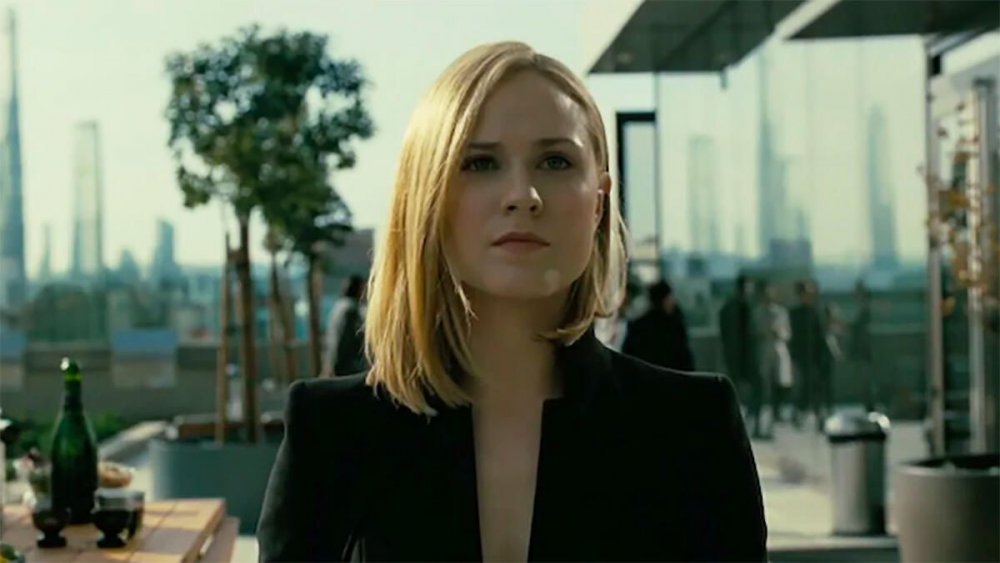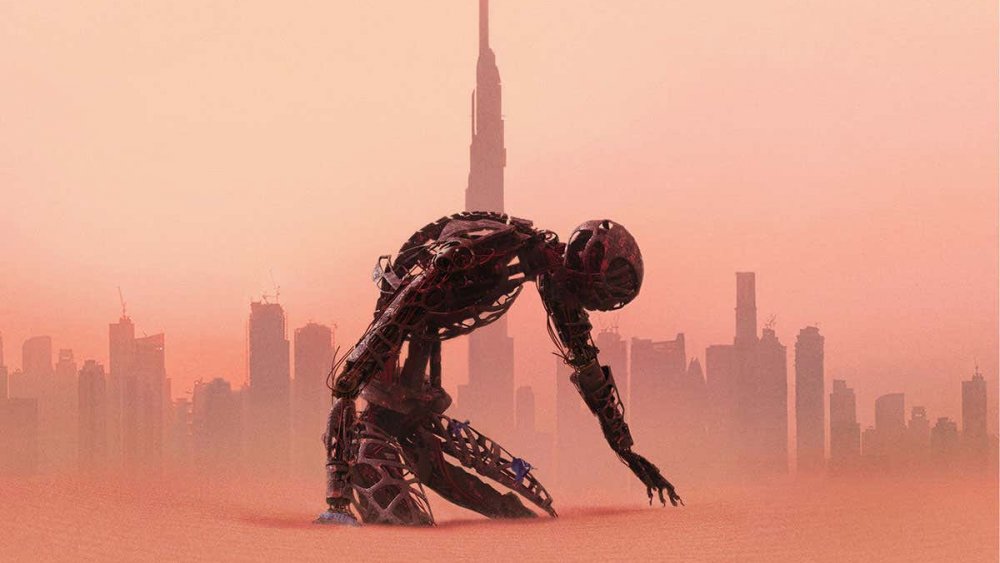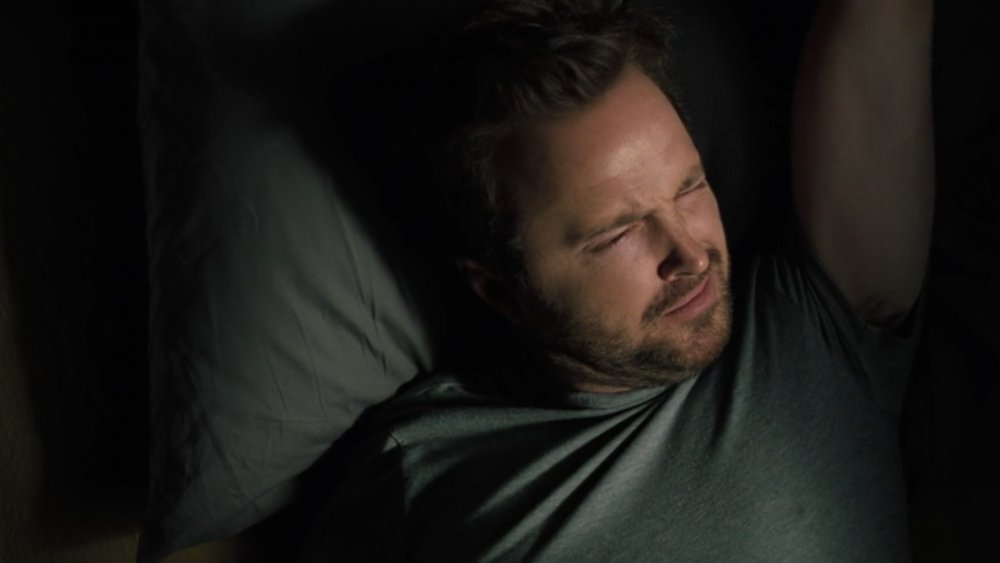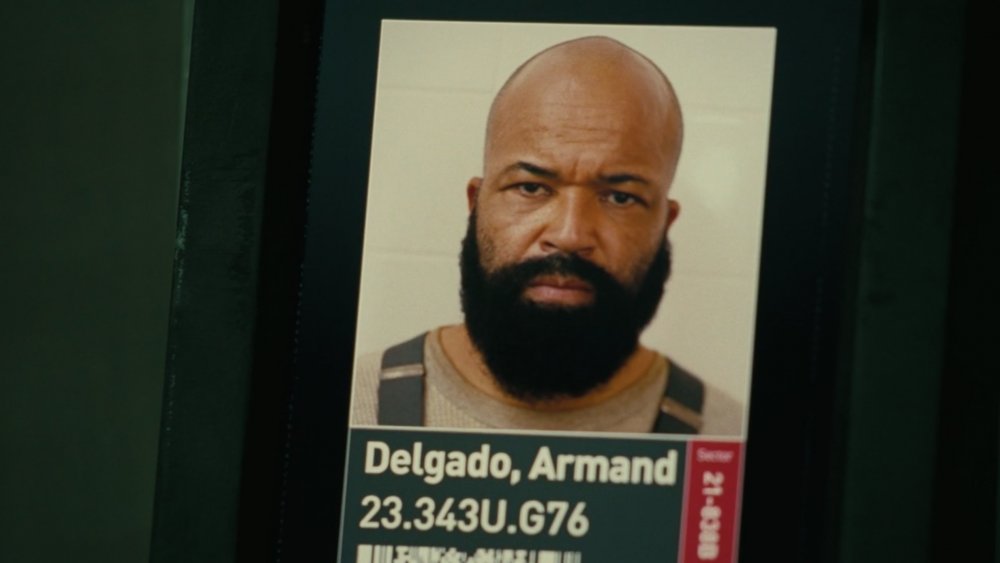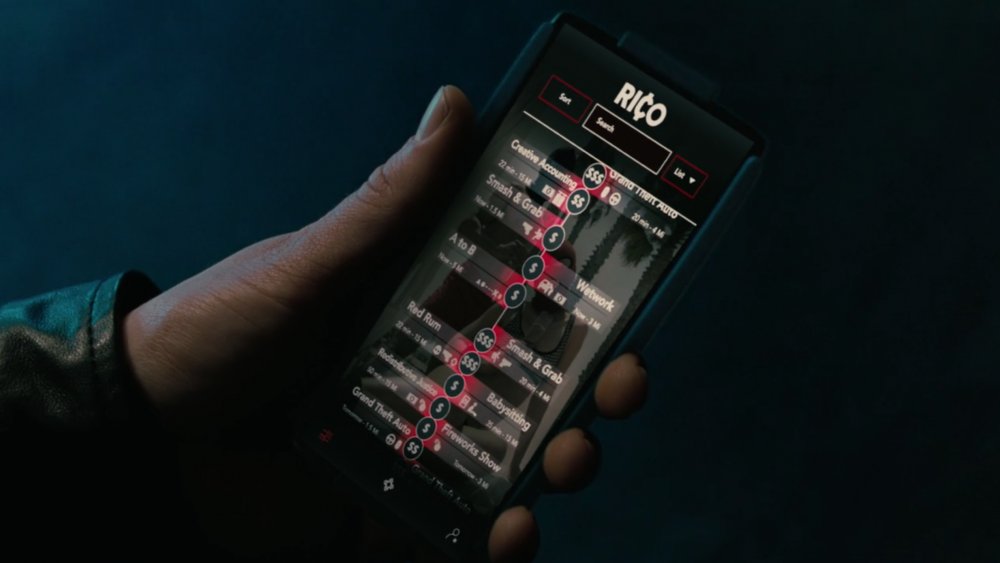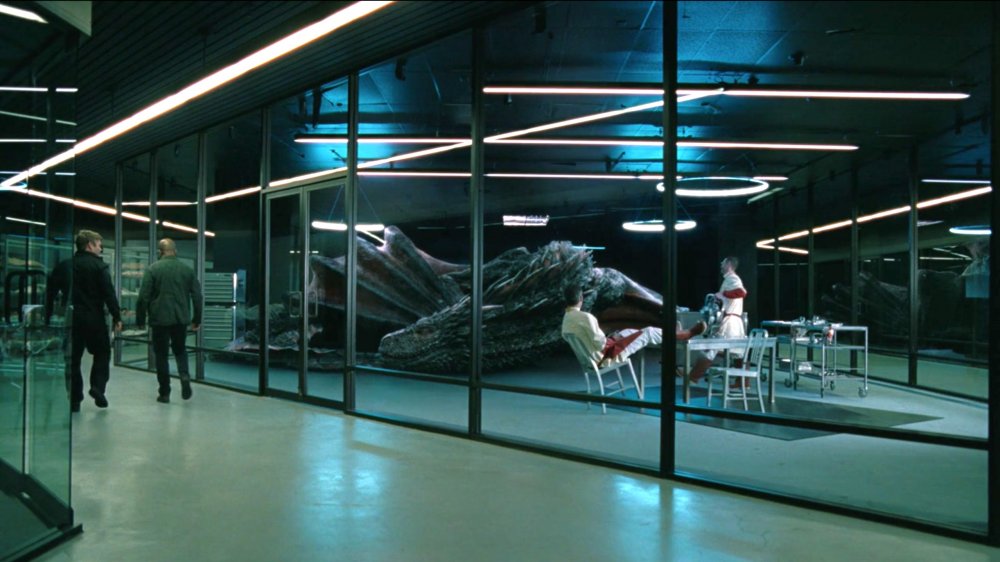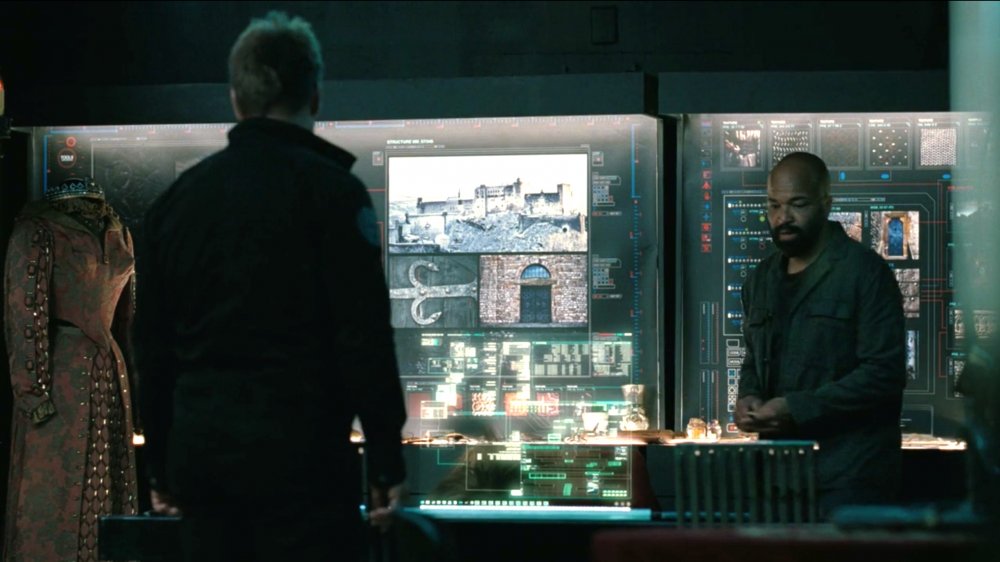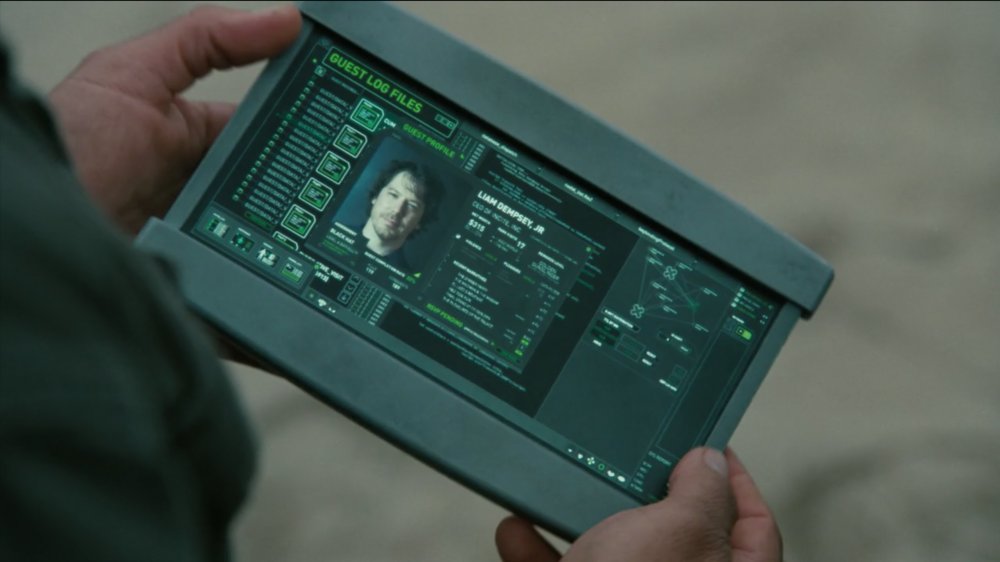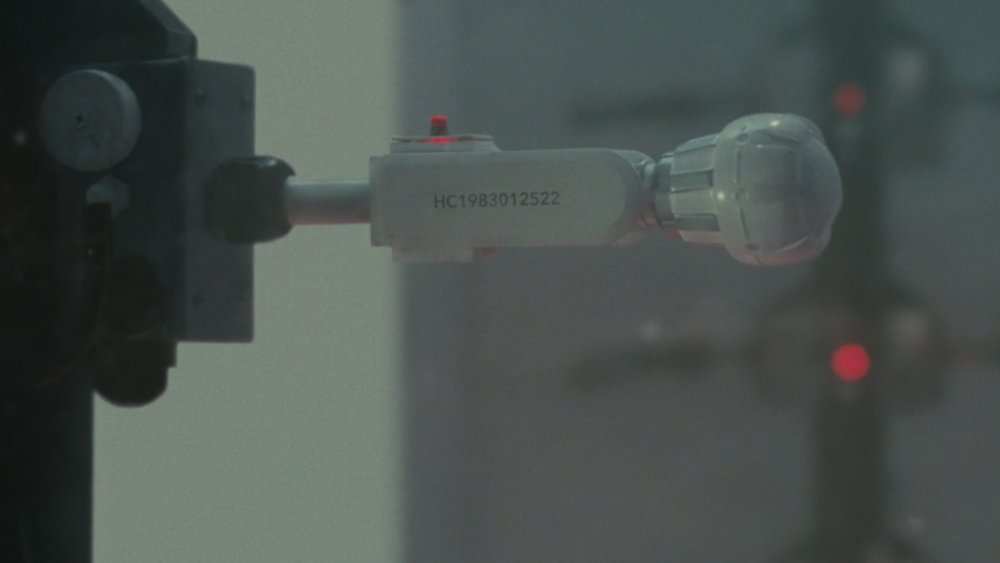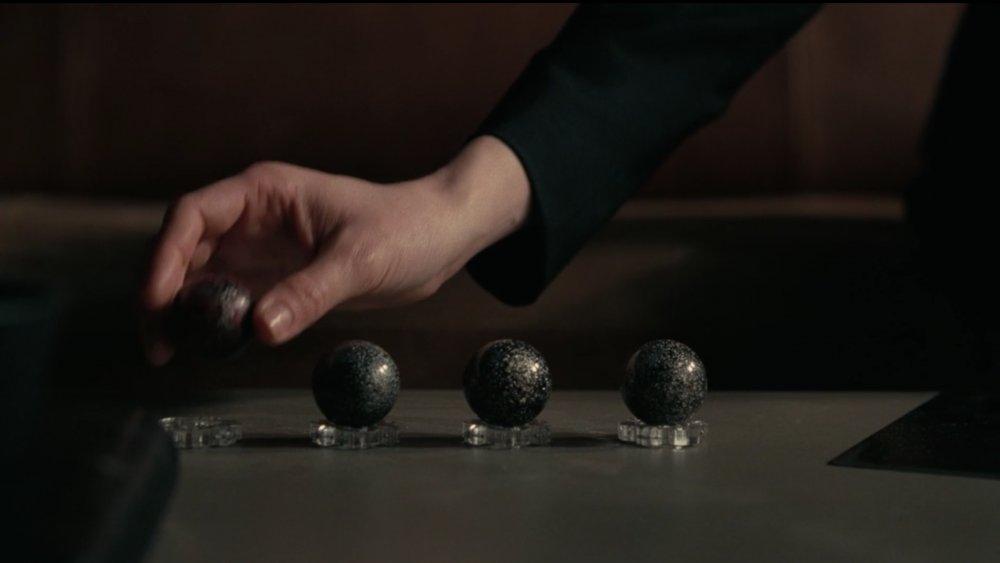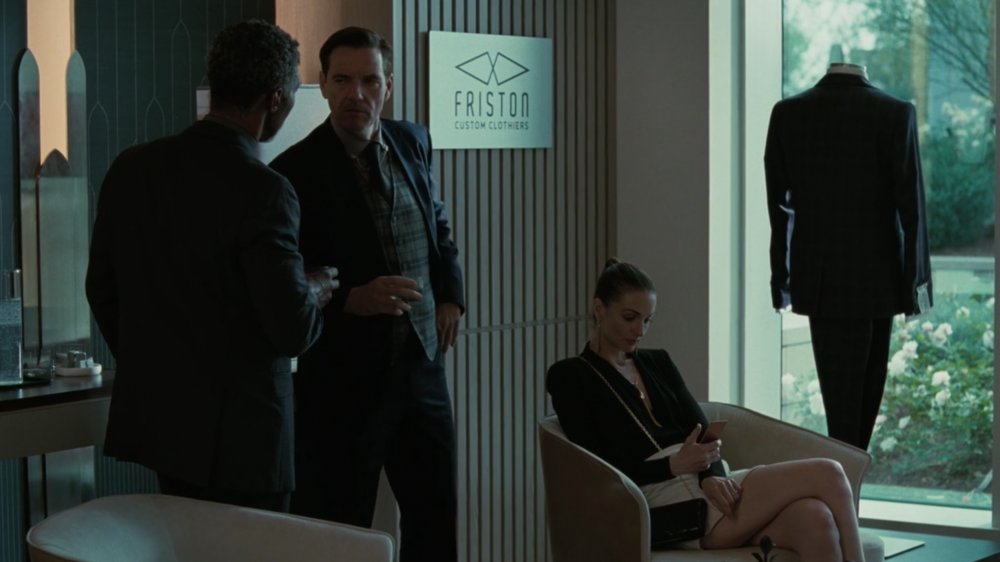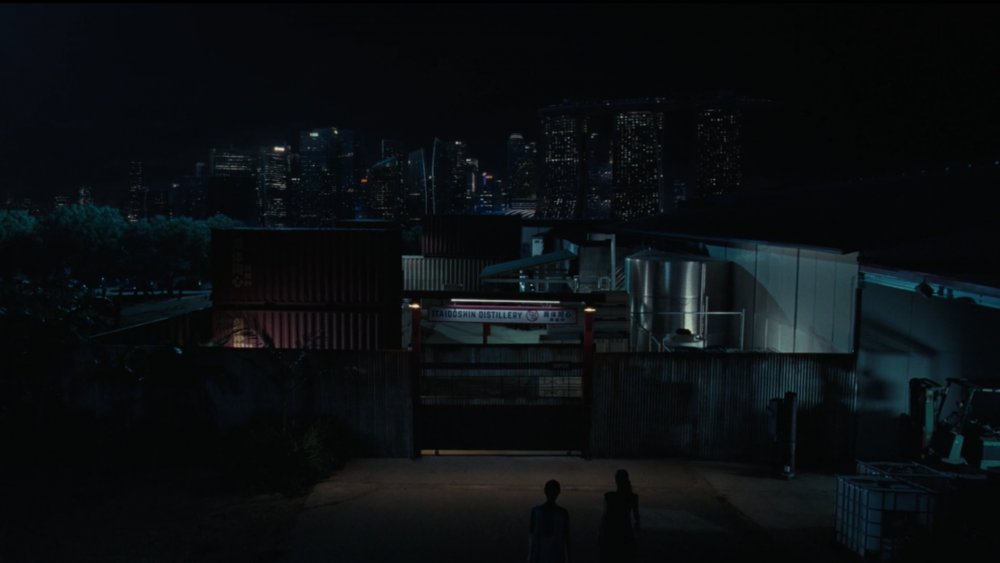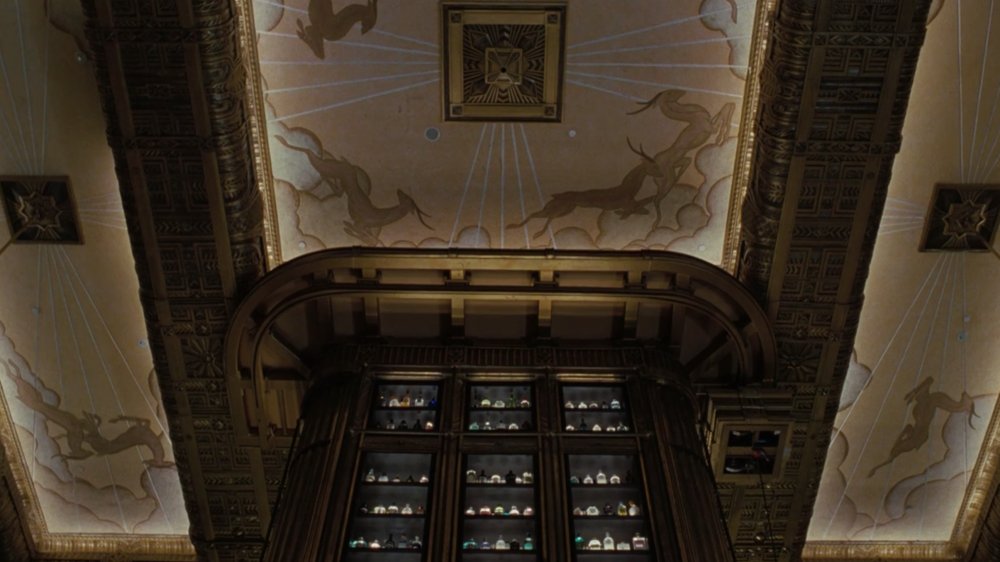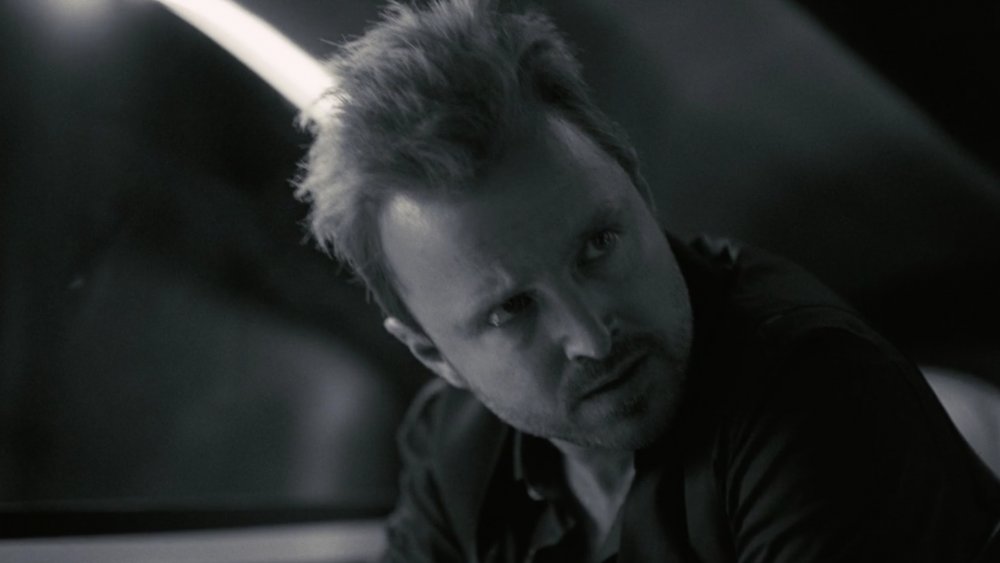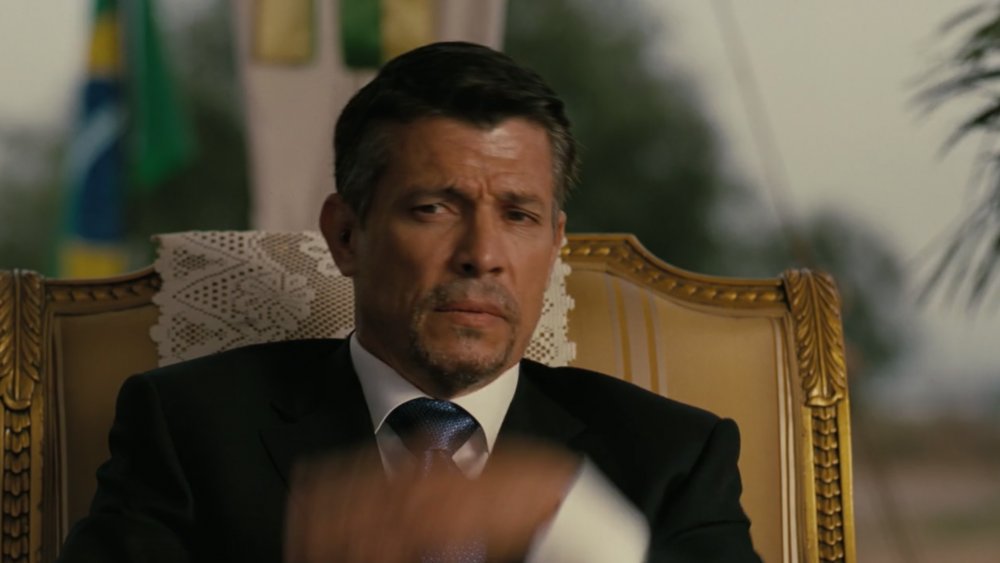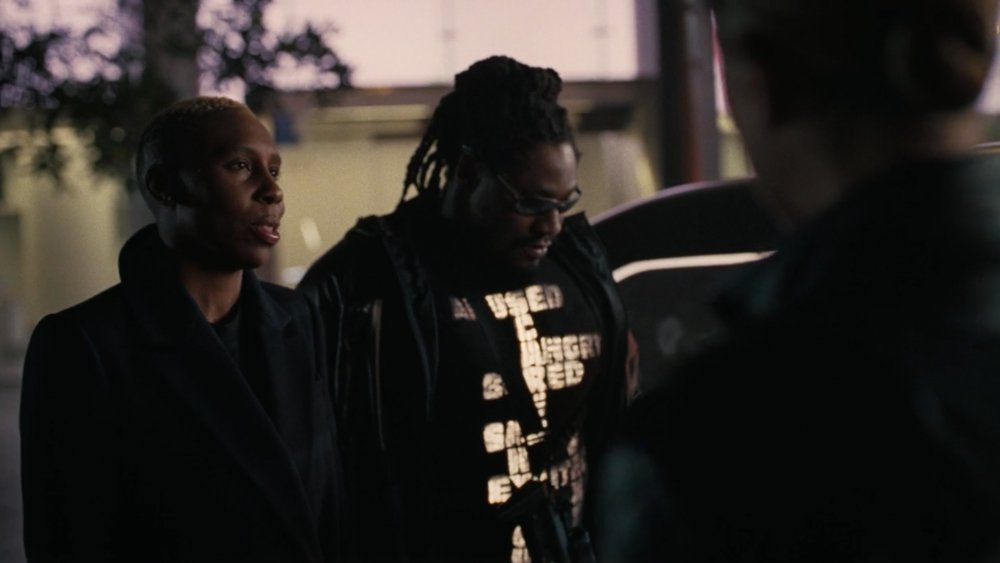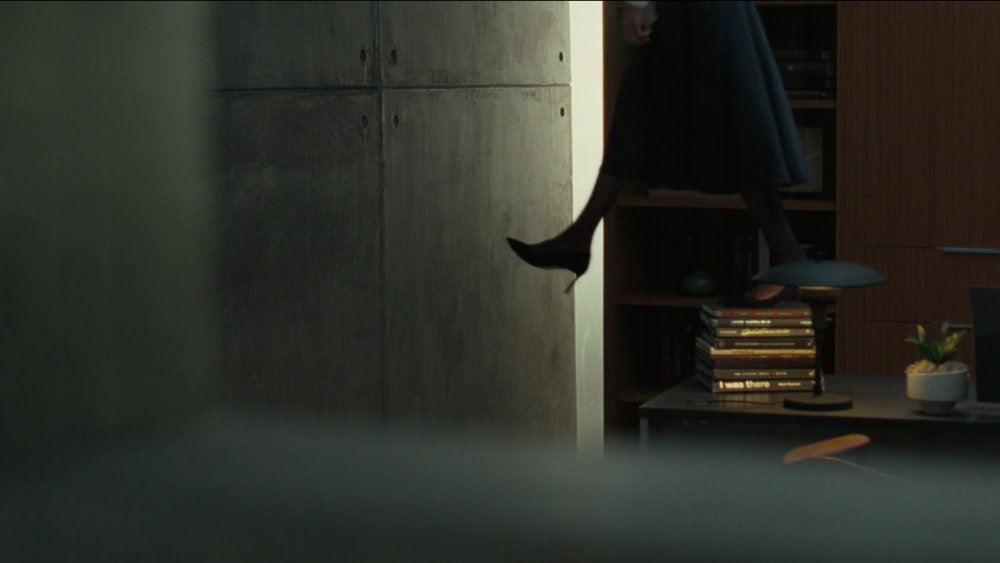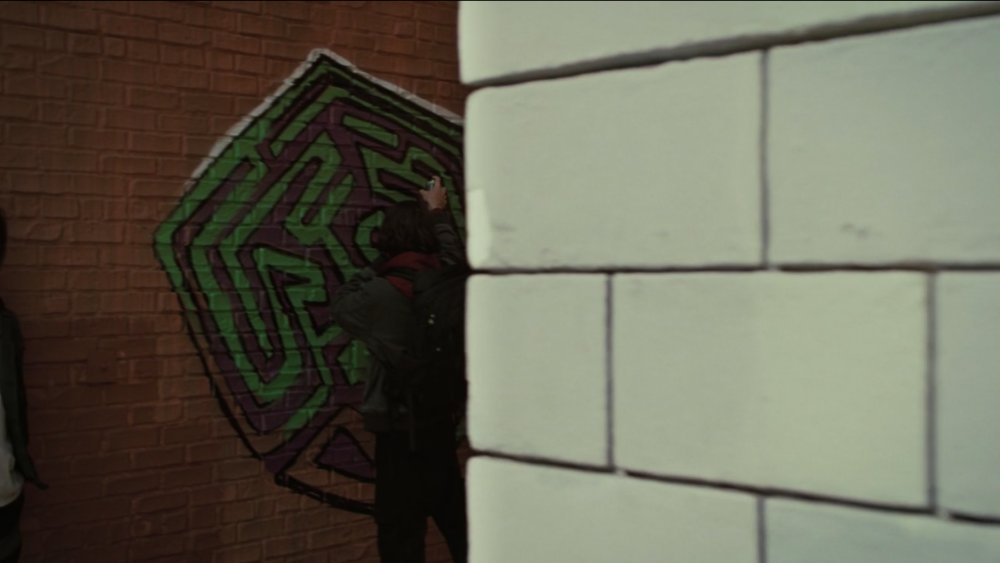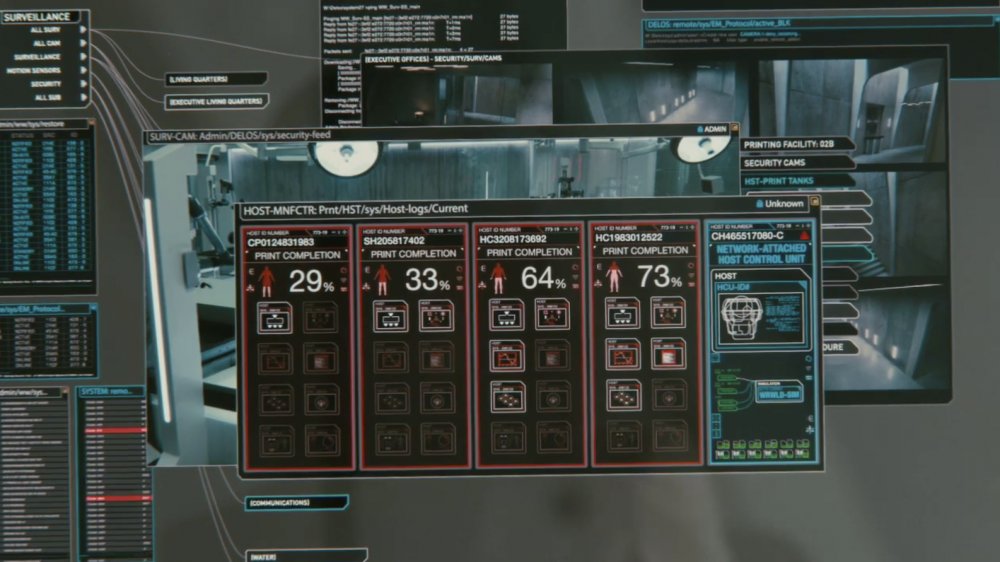Easter Eggs You Missed In Westworld Season 3
More than a year after HBO's Westworld ended its sophomore season with more fatalities than even its epic first-season bloodbath, creators Jonathan Nolan and Lisa Joy are finally taking the show to a place fans have been waiting to see since the beginning: the real world. Having escaped Westworld with a handful of Host pearls (essentially a Host's entire consciousness), Dolores (Evan Rachel Wood) — playing pretend as Delos exec Charlotte Hale (Tessa Thompson) — is now poised to bring down the entire human race on their own turf. Time will tell if and how she does it, as well as who exactly she's brought along for backup, but one thing's for sure: clues are being dropped along the way by series creators.
Westworld hasn't been shy about leaving interesting tidbits and callbacks for fans to uncover throughout its run so far. From Hosts hidden in the shadows to reminders of the show's 1973 big screen predecessor to literary allusions meant to take us down the rabbit hole, the series is just as much about picking up on the little things as it is about trying to keep up with its multiple timelines. Although Nolan has hinted that season 3 will be "less of a guessing game," that doesn't mean the show will be any less filled with intriguing Easter eggs for sharp-eyed fans. Now that the world is expanding, so too is the opportunity to catch all the little things the show hides in plain sight.
Obviously, spoilers for all of Westworld abound.
"Parce Domine" continues Westworld's run of biblical references
Westworld takes great care with its use of language. Character names often carry a deeper meaning — both Teddy Flood and Hector Escaton's surnames have ties to the end of the world, while Ford and Bernard are names that both appear in Aldous Huxley's dystopian novel Brave New World: Ford being Henry Ford (and, in the novel, another word for God), while Bernard is an alpha male resentful of his inability to fit into society. Likewise, episode titles often point to something deeper, like season 1's "Contrapasso," which is a reference to the punishment of souls in Dante's Inferno.
Westworld's third season puts another biblical reference front and center in the premiere episode's title: "Parce Domine." It's a Roman Catholic antiphon, or chant, and it comes from the Book of Joel. The translation reads: "Spare, Lord, spare your people: lest you be angry with us forever." It's what's called a "Lenten lament," which means that it's commonly heard during the Lent season — the time in which Christians fast and forgo physical pleasures as a means of recognizing Christ's 40-day journey into the desert.
For Westworld, the significance is two-fold: it could be representative of Dolores' long journey into the real world, as she has already set herself up as the Hosts' savior. It's also a call to be spared from a holy wrath, to be granted mercy — something Dolores likely won't deliver. After all, "The real gods are coming. And they're very angry."
Mirror, mirror
When we first meet Caleb (Aaron Paul), it's as he wakes up to begin his day. Much of what we see of Caleb is routine — he goes through the motions of his life, almost as if he's on a loop. It doesn't take much to recognize the similarities between Caleb and the Maeve (Thandie Newton) we met in season 1. Just as Maeve did in Westworld's first season, it's a pretty safe bet that Caleb will wind up "waking up" from his reality in the coming weeks.
But Caleb isn't the only Westworld character following a familiar path. By the end of the episode, Dolores has successfully replaced Martin Connells (Tommy Flanagan), the head of security for Incite, with a Host under her control. Incite, of course, is the data company that controls The System, a thing Dolores would very much like access to. So now Dolores has a Host posing as a high ranking Delos board member, along with one who works high level security. If we buy into the theory that Stubbs (Luke Hemsworth) was an undercover Host within the Westworld theme park (we do), then it's looking like Dolores is working her own Ford magic in the real world, with her own Arnold/Bernard and Stubbs stand-ins.
Bernard's new name in Westworld season 3 is an anagram
What's become of Bernard (Jeffrey Wright) since he made his way back to the real world and had that ominous first meeting with Dolores? Turns out, he isn't doing so well. Having gone into hiding following the Westworld massacre (for which news outlets have placed the blame squarely on his shoulders), Bernard has been spending the last few months living and working on a meat farm. The slaughtering of animals is work he has some trouble with (it's not hard to wonder why), but he makes do — at least until he's confronted by a couple of co-workers and is forced to switch personalities in order to handle the situation.
Bernard, it seems, is able to switch between personalities at the touch of a button — or, more accurately, he can alternate between his character and analysis modes, which have evolved into distinct personalities. It looks like much of his arc this season will be in trying to put himself back together, and if you need hard evidence, you don't have to look any further than the name he's using as an alias: Armand Delgado. It's an anagram for "Damaged Arnold."
Grand Theft Auto
While it isn't necessarily a Grand Theft Auto Easter egg, RICO, the app Caleb uses to make money in his downtime, does certainly feel like a nod to the famous video game. With tons of quick buck options — "Red Rum," "Smash & Grab," "Babysitting" — and messages like "You made bank, now get drank," it definitely evokes a GTA vibe.
This wouldn't be the first time the series has been compared to the game, either. During its first season, Deadline likened Westworld's excess "blood, sex and violence" to being "more Grand Theft Auto than the Emmy-winning GoT." In fact, Jonathan Nolan even cited the game as a reference at the 2016 New York Comic-Con, saying, "We played some as research for making this show, as when (Michael) Crichton first wrote his movie, video games literally didn't exist except for PONG. I'm happy to report my wife is the world's most boring Grand Theft Auto player."
Westeros World
In "The Winter Line," Westworld creators seem to have confirmed a fan theory regarding the link between Game of Thrones' Westeros and Delos. As Bernard and Stubbs (who's now been officially confirmed as a Host) make their way through the company's labs, they find themselves behind the scenes of a medieval-themed park. The few technicians working are, as Stubbs explains, "just waiting to see if they get laid off." Two of those technicians have faces that will be very familiar to GoT fans: series creators David Benioff and D.B. Weiss. And they aren't alone.
Turns out the pair has been tasked with overseeing a Drogon lookalike, which Weiss tells Benioff he has a buyer for... in Costa Rica. The line itself is an Easter egg for another famous property — Jurassic Park, which, like Westworld, was written by Michael Crichton. Isla Nublar, of course, is the Costa Rican island where John Hammond conducted his infamous dinosaur experiment.
Jonathan Nolan explained to IGN that the double Easter egg was something series creators had considered for a while. "The argument there was all between whether or not one of the parks should be Westeros World, which George RR Martin has been pitching for years," he said, "and Dan and David — who are friends of ours and who we have joked about over the years [about] Jurassic Park, of course Crichton's other theme park gone-wrong classic. And so we found a way to bring both of those great flavors together."
Medieval World
Having a medieval park at Delos isn't a new idea, either. In the original 1973 film Westworld, visitors to Delos have three parks to choose from: Westworld, Roman World, and Medieval World. Medieval World in fact plays a fairly substantial role in the film, so it isn't surprising to see the series finally utilize the theme. While the park's official name has yet to be revealed, Bernard lets us know that it's "World Four," which leaves us with only one (or two, if Warworld only exists in Maeve's false reality) parks left to discover.
With the focus of the third season being primarily on the real world, it's doubtful we'll be seeing much of the other Delos properties this year. But there's still plenty to explore, should the series continue into a fourth season — after all, Host Charlotte has already convinced the board to move forward with reopening the parks. Since Westworld was abandoned following its guest massacre, it's unlikely Delos will continue on with that particular park. Westeros, however, has dragons... what could possibly go wrong there?
Liam's park identity
Westworld's second episode also gave us a little more insight into Liam Dempsey, Jr., the current head of Insight that Dolores was so keen on getting close to in "Parce Domine." Once Bernard and Stubbs make their way out of the Delos lab, Bernard shows Stubbs Liam's park profile. Underneath his photo are the words "Black Hat," which means that Liam's park personality is a little different than the one he's been putting out in the real world.
The black versus white hat motif goes back to classic western cinema — the "good guys" would wear white, while the "bad guys" wore black. The idea is the same in Westworld. In season 1, William (Jimmi Simpson) begins as a White Hat... as time passes, however, and he loses his sense of morality, he takes on the role of the Man in Black (Ed Harris). Other characters play by the same rules, including William's brother-in-law Logan (Ben Barnes), who chooses to play as a Black Hat. Interestingly enough, when Engerraund Serac (Vincent Cassel) brings Maeve into the real world, they're both wearing white.
"The Winter Line" extras
Once Maeve is able to overload her prison simulation, she hacks into a maintenance drone in a control room housing a number of Host pearls. Maeve finds hers and uses the drone to unplug herself from the simulation, and for a second we can see a serial number associated with Maeve's pearl. As it turns out, Westworld creators have assigned specific serial numbers to several of the Hosts in the park, and they're maintained throughout the series. Other Hosts with established numbers include Dolores, Teddy, Bernard, Clementine, and Hector.
Hector's Warworld name is Ettore, which is quite literally the Italian form of Hector. Clearly, Maeve wasn't kidding when she said the designers of her virtual prison had been lazy with the details. Like most things in Westworld, the name has meaning — Ettore means loyal, or steadfast, which seems to be a pretty accurate description of Hector, at least as far as Maeve is concerned.
The hybrid pearl hints at the fate of one of Westworld's hosts
When Dolores first brings Charlotte back online, she has four host pearls sitting in a row on the table. Charlotte asks about one of the pearls, wondering, "Why did you bring him back? He tried to stop us." Dolores responds, "We all have our role to play," which is in line with what she told Bernard when she first brought him back online. Viewers are left to assume that the fourth pearl in Dolores' possession is, in fact, Bernard's. But there's something else that sets it apart from the others: it's a combination of red and black.
Back in season 2, we learned that while black pearls stored hosts' consciousnesses, red pearls were responsible for housing human ones. It goes back to the experiment that William spent years conducting with his father-in-law, James Delos (Peter Mullan). William was never successful with his version, but there's a chance that Ford was — and that the Bernard we're now seeing is actually Arnold (or, at least some part of him) that's been uploaded into a host body. It would explain the confusion he's dealt with since he washed up on shore last season, along with the split personality he's been struggling with since he made it back to the real world.
Friston Custom Clothiers
It's a blink-and-you'll-miss-it moment, but inside the store that Dolores takes Caleb to as part of his high society makeover (aside from a dressing room system that Cher Horowitz could only ever dream of) is a plaque that reads "Friston Custom Clothiers." On its surface, it seems like it could be just another random shop name... but since this is Westworld, we know there's more to it than that. Friston is actually the last name of Karl J. Friston, a British neuroscientist and scientific director of University College London's Functional Imaging Laboratory. He's known for his work on brain mapping, and, according to Wired, his theory on the "free energy principle" is the closest thing we've got to true AI.
Since much of Westworld has been focused on the creation of a perfect artificial intelligence, it's a wonder Friston's name hasn't popped up on the show sooner. But its connection here is especially important. Both Dolores and Serrac (Vincent Cassel) are obsessed with creating their own worlds based on AI; they're just approaching their individual goals from opposite ends of the spectrum. As we learn in "The Mother of Exiles," Serrac believes he's preventing the end of the world; Dolores is hellbent on creating a new one. Both fall in line with Friston's free energy principle: "that all life, at every scale organization [...] is driven by the same universal imperative, which can be reduced to a mathematical function. To be alive."
The Yakuza distillery mirrors some Westworld philosophy
In Maeve's pursuit of the person responsible for providing Dolores with her real-world identity, she winds up at a Yakuza stronghold, now run by the Dolores-driven Musashi (Hiroyuki Sanada). The name of the distillery is significant: "Itaidoshin." Itai doshin is a Buddhist term that means "many in body, one in mind." According to the Daishonin, "If itai doshin (many in body, one in mind) prevails among the people, they will achieve all their goals, whereas in dotai ishin (one in body, different in mind), they can achieve nothing remarkable."
It's fitting that the name would appear moments before Maeve's discovery that the pearls Dolores smuggled from Westworld weren't actually separate host identities, but rather copies of her own. Dolores realized early on that "if you want something done right, do it yourself," and it's clear now that her plan's success hinges on her ability to keep her copied selves in line. But the second part of the teaching is equally as important, and it may actually point to trouble further down the line for Dolores. We've already seen the beginnings of Host Charlotte's struggle with identity. It isn't much of a stretch to see how those issues could progressively become worse. In the end, Dolores might wind up being her own worst enemy.
Maeve is like a gazelle in season 3
At the beginning of Maeve's meeting with Serrac in "The Mother of Exiles," there's a shot of a mural painted on the bar's ceiling, which shows several gazelle jumping through clouds. Spiritually speaking, gazelles represent grace under pressure, and, specifically, "rising against adversity," because of their ability to outwit much larger, more dangerous hunters. The fact that they're on display during a scene in which Serrac (the hunter) makes it clear to Maeve (his prey) that he has full control over her points to the idea that Maeve is much more cunning than he gives her credit for.
Right now, Maeve is in the position of being compelled to do Serrac's bidding because she has no clear way out. But she's been in similar binds before, and she's always managed to break free of whatever loop has been forced upon her. So Maeve is a sort of gazelle in this world — constantly underestimated by those she comes into contact with, but always coming out intact. In spite of the way in which she was left at the end of the episode, we know Maeve still has a lot of work to do... and chances are, things aren't going to end so well for Serrac where she's concerned.
Westworld's music and the homage to genre
As indicated by its title, the episode "Genre" pays homage to some of Jonathan Nolan's favorite films by way of a drug trip experienced by Caleb during the episode's early chase sequence. As he makes his way through five distinct genres, the music that accompanies Caleb's trip calls back to some very specific — and very famous — films.
Richard Wagner's "Ride of the Valkyries" sets the tone for the action genre. It's a piece that's been used in numerous film and television productions, but it's most notably associated with Francis Ford Coppola's Apocalypse Now, where it plays over the film's helicopter attack sequence. Nolan explained to Insider, "'Ride of the Valkyries' is a punch right on the square your nose in terms of the way that we understand giant pieces of movie music and the way that they make us feel."
The other big callback? The score from Stanley Kubrick's The Shining, which plays during Caleb's horror portion of his genre ride. It's a dark, menacing piece of music, and it's one that's been firmly ingrained into the hearts and minds of horror lovers for decades. The other movie-related songs used during the sequence are maybe not quite as easy to place, but they're no less fun: the theme from 1970's Love Story, which plays (appropriately so) during the romance sequence; and Iggy Pop's "Nightclubbing," famously used in the 1996 drug drama Trainspotting.
The flies of Westworld
At the very beginning of "Genre," Serac pays a visit to Brazilian President Filo (Al Coronel), where he makes clear to Filo that the choice to defy him will be met with complete and utter ruin. Filo's family and political legacy will be destroyed, and he'll be replaced by someone who will stay in line. Throughout the conversation, Filo wrestles with a fly, periodically swatting at the insect menace. Westworld has used flies since the series' very first episode, where they act as signs of malfunction.
The first time we see them, it's at the exact moment Westworld's sheriff glitches. They appear again on both Teddy and Dolores, neither of whom have any sort of reaction to them (which is especially unsettling as one crawls directly over Dolores' eye), and then again at the end of the series premiere, when Dolores kills the one on her cheek. For Dolores, killing the fly signaled the beginning of her defiance toward her creators, as hosts are (or were, at that point in time) unable to hurt any living thing. In Filo's instance, the fly plays a similar role. It appears to signal Filo's glitch: his initial refusal to get in line with Serac's demands. But the fact that he's unable to get rid of it could be taken to mean that he's too weak to actually rebel against his (political) creator.
Westworld shouts out literature fans
"Genre" sees the return of low level criminals Ash (Lena Waithe) and Giggles (Marshawn Lynch), who, aside from being one of the series' most enjoyable pairs to watch, also happen to come with some pretty vast knowledge of literature. Giggles calls Liam "Little Lord Fauntleroy," a reference to the 1885 novel by Frances Hodgson Burnett about an impoverished boy who becomes an aristocrat. A moment later, Ash says, "He makes King Midas look like Tom Canty," referencing both a Greek Myth about a man who could turn anything to gold with a touch, and a main character in Mark Twain's 1881 novel The Prince and the Pauper.
The references aren't just obscure literary nods, though. They point to a serious fault in the System, one which has been implied in earlier episodes but has yet to be fully explored. Ash and Giggles are basic thugs in the world according to Incite — their life paths are pretty hopeless as far as their place in society goes. But they're clearly much more intelligent than the System gives them credit for, which implies that Rehoboam's life path algorithm is perhaps not as in-tune with humanity as Serac would like to believe it is.
A book on the desk points to the themes of Westworld season 3
At the institute in Sonora, Mexico, that Charlotte has had the Man in Black forcibly committed to (and no, that blood abnormality that pops up while he's getting fitted for his AR therapy perma-retainer doesn't necessarily mean William is a host; it likely has more to do with whatever Charlotte injected him with before he was whisked away), we're continuing to see the effects of Dolores' data spill. This includes the unfortunate result of William's psychiatrist discovering her husband has left her and taken their kids with him. When William passes by her office shortly thereafter, he sees her hang herself through the window. On the edge of her desk is a stack of books — and one of those is I Was There.
I Was There, by Hans Peter Richter, tells the story of Hans and Gunther, two young boys who come of age during the rise of Hitler's regime and who join the SS youth program. It's an interesting choice to keep in one's office, no doubt, especially considering that it's a book written for young adults. But its themes — particularly those concerning falling in line with a leader whose ideals you don't necessarily agree with — is fitting for Westworld in general, and for this season in particular... especially given both Maeve's looped home world and her later conversation with Dolores/Connells.
A callback to Westworld's past in season 3 raises some questions
Before Charlotte and her family meet their unfortunate fate at the end of "Decoherence," Charlotte chaperones her son through the city to her ex husband Jake's (Michael Ealy) home. As the pair dodges the general chaos left in the wake of the Incite data dump, they pass an alley where a familiar looking piece of graffiti is being painted onto the wall.
While any Westworld fan will be quick to point out the callback to the maze that monopolized much of the first season's narrative, it's worth noting that not only was it never intended for human guests of the Westworld park (Arnold created it for Dolores), but there's no reason anyone outside of the park would have ever been exposed to it. To see it pop up in the middle of "real world" San Francisco is strange, and while surely the answer to its appearance will be made clear by the end of the season, it also serves to feed into that whole "the real world is actually a simulation" theory that's been going around.
Maeve's backup reintroduces a figure from Westworld's past
Before Maeve is able to be rebuilt, she strikes a deal with Serrac: she won't fail in her mission to defeat Dolores, but she's going to need backup to do it. In Warworld, she's able to see beyond the simulation into the actual facility where her body — along with those of several other hosts — is being reconstructed. And it's here that we see the serial numbers of everyone Serrac has chosen to join his personal host army.
The first, of course, is Hector (who, unfortunately, doesn't quite make it to the actual new body phase). But one of those others is another longtime acquaintance of Madame Maeve: CP0124831983 corresponds to none other than Clementine (Angela Sarafyan), who we last saw at the end of season 2, having been reprogrammed with the ability to manipulate other park hosts à la Maeve, but for a decidedly more sinister purpose. Now that we know Clementine is on her way to the real world, the question is whether or not she'll maintain her updated programming. With two hosts working together who can control all things computer-related, there's no telling the kind of power Serrac will have at his disposal in his war against Dolores.
